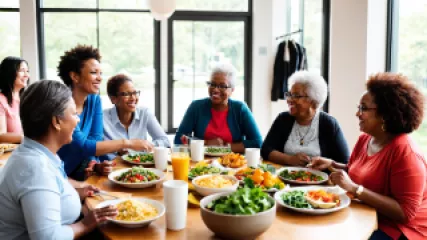The Ultimate Guide to Finding Community Support
The Ultimate Guide to Finding Community Support
Building a strong support network is crucial for our overall well-being. When we feel connected to a community, we're better equipped to navigate life's challenges and find the resources we need to thrive. However, for many people, finding that sense of community can be a daunting task. Whether you're new to an area, struggling with a personal issue, or simply looking to expand your social circle, the process of establishing meaningful connections can feel overwhelming.
In this ultimate guide, we'll explore the why and how of finding community support. We'll delve into the benefits of community engagement, provide practical strategies for identifying and accessing support resources, and offer insights from experts on cultivating meaningful connections. By the end of this article, you'll have a roadmap for building the community support system that's right for you.
The Importance of Community Support
Community support is more than just having a group of friends or acquaintances. It's about finding a sense of belonging, mutual understanding, and shared purpose. When we feel connected to a community, we're better equipped to navigate life's challenges and access the resources we need to thrive.
Improved Mental Health
Studies have consistently shown that strong social connections and a sense of community can significantly impact our mental health. When we feel supported and understood by those around us, we're less likely to experience feelings of isolation, depression, and anxiety. Community engagement can also provide a sense of purpose and self-worth, which are important for maintaining good mental well-being.
Enhanced Physical Health
The benefits of community support extend beyond our mental health. Research has also shown that individuals with strong social connections tend to have better physical health outcomes. From reduced risk of chronic conditions to improved recovery from illness or injury, community engagement can have a positive impact on our physical well-being.
Increased Access to Resources
Being part of a supportive community can also provide access to valuable resources and information. Whether it's learning about local support services, finding job opportunities, or discovering new hobbies and interests, community connections can open doors and expand our horizons.
Greater Resilience
When faced with life's challenges, having a strong support network can make all the difference. Community support can provide a sense of stability and encouragement, helping us to navigate difficult times with greater resilience and adaptability.
Identifying Your Community Support Needs
The first step in finding community support is to take a honest look at your current needs and circumstances. What kind of support are you seeking? Are you looking for emotional support, practical assistance, or a combination of both? Consider the specific challenges you're facing and the resources you may need to address them.
It's also important to reflect on your personal preferences and communication style. Do you prefer one-on-one interactions or larger group settings? Are you comfortable reaching out to strangers, or do you prefer to build connections within your existing social circles? Understanding your own needs and preferences will help you identify the right community support resources for you.
Strategies for Finding Community Support
Once you've identified your community support needs, it's time to start exploring the various avenues for finding the connections and resources you're looking for. Here are some strategies to consider:
Seek Out Local Support Groups
Many communities offer various support groups and organizations that cater to specific needs or interests. These can be an excellent way to connect with others who share similar experiences or goals. Whether it's a mental health support group, a hobby-based meetup, or a community organization, these in-person gatherings can provide a sense of belonging and mutual understanding.
Utilize Online Communities
In today's digital age, online communities have become a valuable resource for those seeking support. From social media groups to specialized forums, the internet offers a wealth of opportunities to connect with like-minded individuals and access information and support. These virtual communities can be especially helpful for those who may not have access to local support resources or prefer the anonymity of online interactions.
Engage with Neighborhood Initiatives
Your local community may offer a variety of neighborhood-based initiatives and events that can help you connect with those around you. Attending community meetings, volunteering for local organizations, or participating in neighborhood clean-ups or block parties can be great ways to meet new people and get involved in your local community.
Explore Faith-Based Communities
For many people, faith-based communities can provide a strong sense of community and support. Whether it's a church, mosque, temple, or other religious or spiritual organization, these communities often offer opportunities for fellowship, service, and personal growth.
Reach Out to Professionals
Sometimes, accessing professional support can be a valuable step in building a stronger community network. Mental health professionals, such as therapists or counselors, can offer personalized guidance and help you develop strategies for expanding your support system. Additionally, career coaches or community outreach workers may be able to connect you with relevant resources and services.
Cultivating Meaningful Connections
Building a supportive community is not just about finding the right resources; it's also about nurturing meaningful connections with those around you. Here are some tips from experts on how to cultivate lasting community support:
Be an Active Participant
"The key to building community is to be an active, engaged member," says Millard Moreno, a community outreach specialist.
"Don't just show up to events or activities; participate, volunteer, and contribute to the group. This helps you establish a sense of ownership and investment in the community, which fosters stronger bonds and a greater sense of belonging."
Practice Active Listening
"When you're trying to connect with others, it's important to be an attentive listener," advises Gary Wilson, a licensed therapist.
"Show genuine interest in the people around you, ask thoughtful questions, and make an effort to understand their perspectives and experiences. This not only helps you build trust and rapport, but it also makes others feel valued and heard."
Be Vulnerable and Open-Minded
"Vulnerability is the cornerstone of meaningful connections," says Gianna Cox, a community organizer.
"When you're willing to share your own experiences, struggles, and emotions, it encourages others to do the same. This mutual openness fosters deeper understanding and empathy, which are essential for creating a supportive community."
Embrace Diversity and Inclusion
"Diverse and inclusive communities are the strongest and most resilient," notes Anahi Graham, a social worker.
"Make an effort to connect with people from different backgrounds, cultures, and life experiences. Celebrate your differences and find common ground. This not only enriches the community but also helps to break down barriers and promote understanding."
Maintaining and Nurturing Your Community Support System
Building a strong community support system is an ongoing process that requires dedication and effort. Once you've established connections, it's important to continue nurturing those relationships and keeping your support network active and engaged.
Regular check-ins, whether in person or through digital communication, can help you stay connected with the people in your support system. Attending community events, volunteering together, or simply making time for social gatherings can also help strengthen those bonds.
It's also crucial to be willing to offer support to others within your community. By reciprocating the care and assistance you've received, you not only strengthen your own connections but also contribute to the overall well-being of the community.
Remember, a supportive community is not something that happens overnight. It takes time, patience, and a genuine commitment to building and maintaining meaningful relationships. But the benefits of a strong support network are well worth the effort.
Conclusion
In today's fast-paced and often isolating world, the importance of community support cannot be overstated. By taking the time to identify your needs, explore available resources, and cultivate meaningful connections, you can build a support system that will enrich your life in countless ways.
Whether it's through local support groups, online communities, neighborhood initiatives, or professional guidance, there are countless avenues for finding the community support you need. By embracing vulnerability, practicing active listening, and celebrating diversity, you can foster the kind of connections that will help you navigate life's challenges with greater resilience and fulfillment.
Remember, the journey to finding community support is unique to each individual, so be patient, open-minded, and willing to try new approaches. With dedication and a genuine commitment to connection, you can unlock the transformative power of community and unlock your full potential for growth and well-being.






